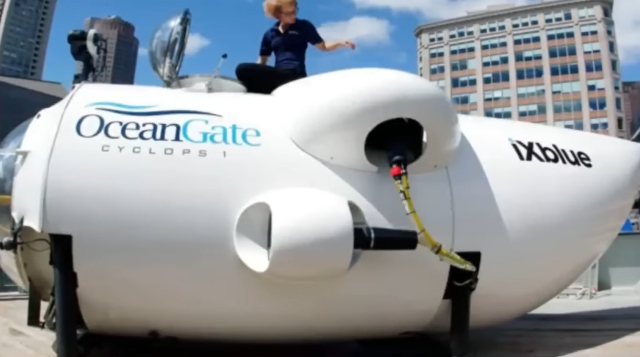
The submersible, which departed for an expedition to the shipwreck of the ill-fated Titanic that sank in 1912, also suffered the passenger line's fate after losing contact with the outside world. The craft with its five passengers sought to explore the Titanic shipwreck 12,500 feet under the waters of the North Atlantic ocean, near the island of Newfoundland in Canada.
Shortly after the Titan's voyage began, it lost contact with the outside world – prompting the U.S. Navy to began listening for it. The Navy heard a suspected sound near the area where debris from the submersible was found on June 22.
"The U.S. Navy conducted an analysis of acoustic data and detected an anomaly consistent with an implosion or explosion in the general vicinity of where the Titan submersible was operating when communications were lost," a senior DoD official said in a statement. "While not definitive, this information was immediately shared with the incident commander to assist with the ongoing search and rescue mission."
The Navy asked that the specific system used not be named, citing national security concerns. According to the Wall Street Journal, it is normally used to detect enemy submarines.
The U.S. Coast Guard – assisted by Canadian and French ships – searched the area where the Titan reportedly imploded and found debris roughly 1,600 feet from the bow of the Titanic wreckage. A person with direct knowledge of the matter said: "It looks that the Titan imploded … on its way down to the Titanic shortly after contact was lost at a depth of around 9,000 feet."
An underwater implosion is the sudden collapse of a submarine when the tremendous pressure of the seawater overpowers the pressure inside the vessel and crushes it. The Titan's implosion destroyed the submersible and killed its five passengers – OceanGate founder and CEO Stockton Rush; British billionaire Hamish Harding; renowned French diver Paul-Henri Nargeolet; Pakistani businessman Shahzada Dawood and his 19-year-old son Suleman Dawood. (Related: Is a Titanic conspiracy theory tied to the sinking of the billionaire submersible?)
Cameron: OceanGate "cut corners" because they knew they wouldn't be certified
James Cameron, director of the iconic box office flick "Titanic," put in his two cents about the Titan's implosion. The 1997 film starring Leonardo Di Caprio and Kate Winslet celebrated its 25th anniversary in 2022.
"I felt in my bones what had happened. For the sub's electronics to fail and its communication system to fail, and its tracking transponder to fail simultaneously – sub's gone," the director said.
"Their [communications] were lost, and navigation was lost and I said instantly, 'You can't lose [communications] and navigation together without an extreme catastrophic event or high, highly energetic catastrophic event.' And the first thing that popped to mind was an implosion."
Cameron also suggested that there was a "terrible irony" in the loss of Titan and its crew, likening it to the loss of the supposedly "unsinkable" ocean liner the submersible and its five passengers sought to explore.
He also told BBC that the team that constructed Titan had "cut corners" and that OceanGate "didn't get certified because they knew they wouldn't pass." Cameron remarked: "I was very suspect of the technology that they were using. I wouldn't have gotten in that sub."
Back in March 2018, the Washington, D.C.-based Marine Technology Society sent a letter to OceanGate. The said letter obtained by the New York Times warned that "the current 'experimental' approach adopted by OceanGate … could result in negative outcomes from minor to catastrophic."
Also in 2018, U.S. court documents showed former OceanGate director of marine operations, David Lochridge, warning of potential safety problems with the vessel. But instead of taking Lochridge's concerns seriously, the company illegally terminated him.
"We now have another wreck that is based on, unfortunately, the same principles of not heeding warnings," Cameron ultimately remarked.
Visit Disaster.news for more stories about events with disastrous outcomes.
Watch this video discussing safety measures that could have prevented the Titan catastrophe.
This video is from the Red Voice Media channel on Brighteon.com.
More related stories:
US Navy to deploy 150 AI-powered "ghost ships" by 2045.
Sources include:
Please contact us for more information.





















